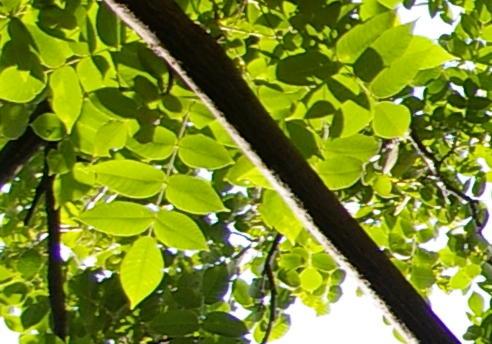GLEBE TREES AND SHRUBS
Butternut (Juglans cinerea)
Form
Grows to be a tall tree.
Leaves
 41-43 Fourth Avenue, June 25, 2008
Butternut leaflets taper fairly markedly toward the leaf base. There is usually a prominent
terminal leaf, which is not typical of black walnut.
41-43 Fourth Avenue, June 25, 2008
Butternut leaflets taper fairly markedly toward the leaf base. There is usually a prominent
terminal leaf, which is not typical of black walnut.
Bark
 41-43 Fourth Avenue, June 25, 2008
41-43 Fourth Avenue, June 25, 2008
Fruit
 41-43 Fourth Avenue, June 25, 2008.
The fruit of the butternut is oval, that of the black walnut spherical. Several are visible here,
if a little fuzzy.
41-43 Fourth Avenue, June 25, 2008.
The fruit of the butternut is oval, that of the black walnut spherical. Several are visible here,
if a little fuzzy.
Similar species
Only black walnut can be confused with it when grown tall.
Butternut is very similar to black walnut, the latter being more common in the Glebe.
Butternut is hairier, stickier, lighter green, generally less elegant leaf features.
The butternut leaflets tend to get smaller moving toward the base. There is usually a prominent
terminal leaflet, whereas it is usually absent on black walnut leaves. The butternut leaf axis
is quite hairy whereas the walnut axis is pretty smooth. The butternut leaflets crowd the axis,
even overlapping it. Not on the walnut leaves. Walnut leaflets seem to me to be quite asymmetrical
at the base, especially toward the tip. Less so on butternut.
The black walnut fruit are spherical but some look almost pear-shaped to me. This may be a
maturation question. Butternut bark has ridges which are apparently more flat-topped than black walnut.
Hickory has far fewer leaflets, resembling ash.
List of trees and shrubs with alternate, compound, toothed leaves
 41-43 Fourth Avenue, June 25, 2008
Butternut leaflets taper fairly markedly toward the leaf base. There is usually a prominent
terminal leaf, which is not typical of black walnut.
41-43 Fourth Avenue, June 25, 2008
Butternut leaflets taper fairly markedly toward the leaf base. There is usually a prominent
terminal leaf, which is not typical of black walnut.
 41-43 Fourth Avenue, June 25, 2008
41-43 Fourth Avenue, June 25, 2008
 41-43 Fourth Avenue, June 25, 2008.
The fruit of the butternut is oval, that of the black walnut spherical. Several are visible here,
if a little fuzzy.
41-43 Fourth Avenue, June 25, 2008.
The fruit of the butternut is oval, that of the black walnut spherical. Several are visible here,
if a little fuzzy.